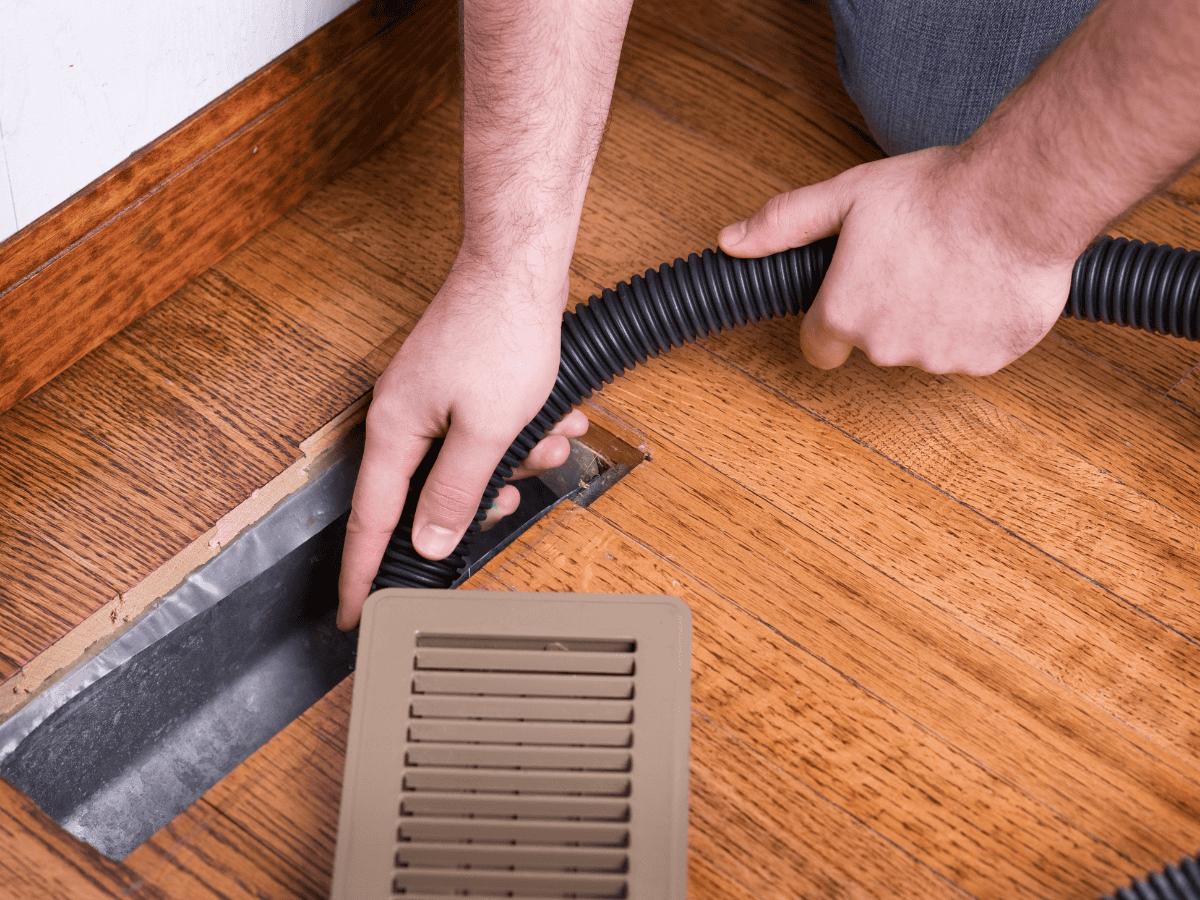Mold in the home isn’t just an unsightly nuisance; it can also be a sneaky health hazard, particularly if it finds its way into your air ducts and vents. If left unaddressed, it can spread through your AC system, causing a musty smell and affecting your home’s air quality.
While mold formation in ductwork is a common problem many homeowners face, for the safety of everyone in your household, it’s important not to overlook it for the safety and well-being of everyone in your home.
Whether you’re addressing this issue with a DIY cleaning or opting for professional help, the goal remains clear: to ensure your living environment is safe, clean, and free from mold-related problems.
Is mold in your air ducts dangerous?
While small amounts of mold in your home might be negligible, high concentrations can pose a significant health hazard to you and your family.
This is especially true if you have infants or young children who could potentially develop breathing or respiratory issues from mold exposure. The elderly may have weakened immune systems, making them more vulnerable. And lastly, anyone with existing conditions can face issues with extended mold exposure.
Such living conditions can exacerbate existing breathing issues or cause new respiratory conditions, such as asthma, allergies, bronchitis, etc., indicating the urgent need for remediation and repair.
Signs you have mold in your ductwork
Mold in your ductwork is dangerous to your living environment, but how can you tell if it’s there? Here are a few telltale signs that might indicate the presence of mold in your air conditioning system:
Visual Clues
Your air vents and ducts can give you some pretty clear hints that mold’s made itself at home. Keep your eyes peeled for:
- Black, green, or white specks around your ductwork and vents could be mold spores. Spots may also spread to the floor or carpet near the vent.
- Unusual markings or patches on your vents can indicate mold growth within your system.
That Smell… Is It Mold?
A musty smell in your home that’s particularly strong when the AC is on is a telltale sign of mold in your ductwork. If the smell persists and you’ve ruled out all other possibilities, it might be your vents.
Humidity and Debris: Partners in Crime
Mold thrives in humid, moist environments. If you have persistent water leaks near your HVAC system, these can create an ideal environment for mold growth.
Excess condensation can promote mold growth in your system, so if your home feels incredibly humid, it might be worth taking a look. Also excessive debris like leaves, pine needles, and sticks in your system cause trap moisture and cause mold.
Recognizing these warning signs early can help prevent the spread of mold throughout your home, ensuring the air you breathe is clean and healthy.
6 Ways to remove mold from your AC system
Wondering how to beat mildew and mold in your system? Fortunately we’ve done the research for you. Here is a list of ways to remove the sneaky fungi:
- Identify and Evaluate the Problem: Start by inspecting your ducts and assessing the severity of mold growth. Flexible ducts may require more delicate professional handling than metal ones. Also, a severe infestation is better handled by an expert.
- Safety First: Before you begin, shut off your system and equip yourself with gloves, a face mask, and goggles. Mold spores are harmful to your respiratory system, especially when disturbed.
- Access and Vacuum: Open the intake valve and other access points to your ductwork. Carefully vacuum the visible mold spores. The suction should pull a lot of the mold off the ductwork.
- Careful Cleaning: Depending on the severity of the mold and the type of your ductwork, use a gentle yet effective solution to clean the affected area. Fungicide and removal kits are likely sold at your local hardware store.
Water and mild detergent mixed together will usually help. For metal ducts with stubborn mold, a solution containing diluted bleach OR vinegar can be more effective (Do NOT use both, as this can create a toxic gas)
Remember, if your ducts are made of porous materials like fiberglass, it’s best to leave the cleaning to professionals.
- Rinse and Dry: After spraying and scrub away the mold, rinse the area with a clean cloth to remove the last of the cleaner. Depending on your climate and the humidity levels in your home, consider using a dehumidifier to speed up the drying process
- Disposal: Get rid of the rags or brushes used and seal them in a plastic bag – no need to encourage spreading!
- Call in a professional for difficult removal jobs: If your mold problem persists despite your best DIY efforts or if the infestation is extensive, it’s time to call in the experts.
DIY vs. professional removal
Assess the severity, location, and type of mold when dealing with mold removal. For minor issues, a DIY approach may work by cleaning affected areas with mold-killing products and maintaining drains and air filters.
However, you should seek professional help for hard-to-reach or severe mold. Professionals have tools to eliminate mold effectively and offer prevention tips. Expert services ensure a healthy home and safe air ducts.
Reach out to River Valley Air Conditioning for guidance on mold issues to create a safe environment.
Tips to control mold in air ducts
Here are some effective ways to prevent mold and mildew indoors:
Keep Your Humidity Levels In Check
Mold thrives in damp places, so keeping humidity levels at bay (30-50%) can help prevent it. Use a hygrometer to monitor the levels.
- Invest in a Dehumidifier: Place dehumidifiers in key areas known for moisture accumulation, such as your basement. It’s best to directly combat high humidity where it’s most likely to occur.
- Efficient Venting: Ensure your clothes dryer is vented outdoors either through the roof or neighboring wall. This seemingly small measure can significantly reduce indoor humidity, reducing excess moisture.
- Targeted Exhaust Use: Incorporate the habit of using exhaust fans during activities that contribute a high amount of moisture to the air, like cooking and bathing. This can help reduce mold throughout your home, not just your ductwork.
Routine HVAC Service and Home Maintenance
These can also be effective in preventing the build-up of dust, pollen, and other allergens:
- Check for leaks, repair them promptly, clean gutters, and direct water away from the foundation to avoid water intrusion.
- Replace or clean your air filters to stop mold spores from circulating. Clear drip pans and drain lines to prevent moisture buildup.
- Professional furnace and air conditioner checks help you identify and address moisture problems.
- Ventilation System Maintenance: Keep home ventilation optimal by regularly cleaning exhaust fans in high-moisture areas like bathrooms and kitchens to prevent mold.
Invest in a Preventative Maintenance Program
Consider River Valley’s Preventative Maintenance Plan. This service helps homeowners take care of their HVAC systems, offering peace of mind and quick action in the event of an emergency, which can be crucial in preventing the onset and spread of mold.
Call River Valley for the best air care for your home.
As summer approaches, particularly in the desert regions of Nevada, Arizona, and California, where the heat can escalate quickly, ensuring your home’s air ducts are free from mold and germs is key to a healthy and comfortable indoor environment.
River Valley Air Conditioning offers expert services to keep your HVAC system at peak performance, significantly reducing the risk of a mold infestation. Our preventative maintenance plan is tailored to address the unique challenges of desert summers, providing thorough inspections and timely interventions.
For more information or to enroll in our maintenance program, contact River Valley today. Don’t wait until it’s too late; proactive care is the best strategy for a fresh and healthy home.

